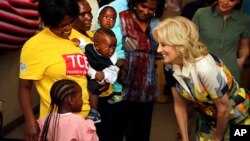Twenty years ago, the human immunodeficiency virus, or HIV, and AIDS, the disease it causes, were considered by many to be an insurmountable plague, particularly in sub-Saharan Africa. An infected person was virtually a dead man walking. For that reason, in 2003, President George W. Bush introduced the U.S. President’s Emergency Plan for AIDS Relief. Universally known as PEPFAR, it is to this day the world’s largest commitment by any nation to address a single disease.
The program’s innovative, science-based HIV prevention and treatment programs have thus far saved 25 million lives and fundamentally altered the course of the HIV pandemic. Today, thanks to PEPFAR, nearly 29 million people are receiving life-saving treatment, while HIV infections have been reduced by 54 percent since the peak of the epidemic in 1996.
Nonetheless, much more remains to be done. In sub-Saharan Africa, AIDS is the leading cause of death for girls and women between the ages of 15 and 49. And even though PEPFAR helped prevent the infection in 5.5 million babies, almost 800,000 children living with HIV do not have access to treatment, without which half will die before their second birthday.
In early August, the State Department announced a new PEPFAR initiative to benefit mothers and infants, Safe Births, Healthy Babies. Slated to begin in 2024, funding permitting, this is a two-year, 40-million-dollar effort to accelerate progress to eliminate mother-to-child transmission in PEPFAR-supported high HIV burden countries.
Since 2010, programs supported by PEPFAR have been able to reduce by half the number of new HIV infections for children by scaling up prevention of mother-to-child transmission interventions. Nonetheless, a number of countries that carry a high HIV burden continue to see high rates of mother to child transmissions, with about 130,000 children newly infected with HIV in 2022.
Over the initial two years of the Safe Births, Healthy Babies program will ramp up the effort to eliminate Mother to child transmissions. After that, the goal will be to reduce the number of babies born infected with HIV by at least 33 percent.
Thanks in large part to PEPFAR, a number of countries have achieved significant success in their fight against HIV/AIDS, proving that an AIDS-free generation is achievable. The Safe Births, Healthy Babies initiative promises to do just that and will advance the global effort to end HIV/AIDS as a public health threat by 2030.














